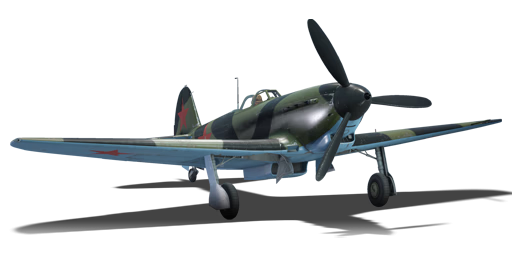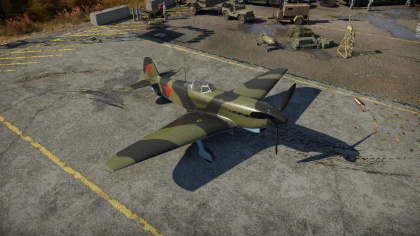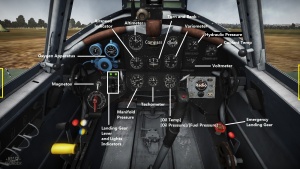Yak-9T
Contents
| This page is about the Russian fighter Yak-9T. For the French version, see Challe's Yak-9T (France). For other versions, see Yak-9 (Family). |
Description
The Yak-9T is a rank III Russian fighter
with a battle rating of 3.7 (AB) and 4.0 (RB/SB). It has been in the game since the start of the Open Beta Test prior to Update 1.27.
General info
Flight performance
Describe how the aircraft behaves in the air. Speed, manoeuvrability, acceleration and allowable loads - these are the most important characteristics of the vehicle.
| Characteristics | |||||||
|---|---|---|---|---|---|---|---|
| Stock | |||||||
| Max Speed (km/h at 4,000 m) |
Max altitude (meters) |
Turn time (seconds) |
Rate of climb (meters/second) |
Take-off run (meters) | |||
| AB | RB | AB | RB | AB | RB | ||
| 577 | 560 | 10000 | 18.8 | 19.5 | 13.7 | 13.6 | 366 |
| Upgraded | |||||||
| Max Speed (km/h at 4,000 m) |
Max altitude (meters) |
Turn time (seconds) |
Rate of climb (meters/second) |
Take-off run (meters) | |||
| AB | RB | AB | RB | AB | RB | ||
| 610 | 593 | 10000 | 17.2 | 18.0 | 18.5 | 16 | 366 |
Details
| Features | ||||
|---|---|---|---|---|
| Combat flaps | Take-off flaps | Landing flaps | Air brakes | Arrestor gear |
| X | X | ✓ | X | X |
| Limits | ||||
|---|---|---|---|---|
| Wing-break speed (km/h) |
Gear limit (km/h) |
Combat flaps (km/h) |
Max Static G | |
| + | - | |||
| 410 | ~12 | ~9 | ||
| Optimal velocities | |||
|---|---|---|---|
| Ailerons (km/h) |
Rudder (km/h) |
Elevators (km/h) |
Radiator (km/h) |
| < 380 | < 420 | < 490 | > 340 |
| Compressor (RB/SB) | ||
|---|---|---|
| Setting 1 | ||
| Optimal altitude | 100% Engine power | WEP Engine power |
| 700 m | 1,260 hp | N/A |
| Setting 2 | ||
| Optimal altitude | 100% Engine power | WEP Engine power |
| 2,900 m | 1,175 hp | N/A |
Survivability and armour
- 64 mm Bulletproof glass in cockpit front
- 64 mm Bulletproof glass pilot's headrest
- 8 mm Steel plate in the pilot's seat.
Armaments
Offensive armament
The Yak-9T is armed with:
- 1 x 37 mm NS-37 cannon, nose-mounted (30 rpg)
- 1 x 12.7 mm Berezin UB machine gun, nose-mounted (200 rpg)
Usage in battles
The Yakovlev 9-T or Yak-9T as it is most popularly referred to in game, being the most popular of the Yak-9 variants, is best played differently depending on the situation the pilot finds themselves in.
To begin, make sure that you take off and immediately climb. A twenty degree angle may be too much to handle depending on the upgrades purchased on the aircraft, so a fifteen degree climb is recommended. With it, the pilot keeps much needed speed and agility. Altitude advantage over your opponent is always preferred, and most pilots of the tier that the Yak-9T fights do not choose to climb over 2,000 m (6,561 ft). A good altitude to climb to is 3,000 m (9,842 ft). In this way, altitude advantage is achieved. Be advised this will not always be the case and some enemies will climb above you. If this happens, try to make them bleed energy until they are slower than you and turn fight them.
At high altitude, the Yak-9T is best suited to energy fighting, which means using the Yak's good energy retention to zoom at an opponent, shoot at them, and then climb up and turn back to your opponent and give chase. The Yak at mid to low altitude is best suited to turn-fighting against all nations except for the Japanese. If facing the Japanese, use the same energy fight tactics as stated above, as Japanese planes will be unable to give chase due to the low energy retention of their lightweight aircraft. The Yak-9T comes equipped with flaps, it is critical you use them, as performance is greatly increased in a turn-fight with them extended.
The Yak-9T and all Yak's suffer from constant engine overheat, properly watching this temperature is critical, because if let go too long, the engine will die and the Yak falls fast. Keep eyes on temp at all times. Best advice is to keep throttle at 90% or lower when not in combat. The Yak-9T is best suited to colder maps, if on a hot map, gain altitude and cruise at 85-90% throttle.
Manual Engine Control
| MEC elements | ||||||
|---|---|---|---|---|---|---|
| Mixer | Pitch | Radiator | Supercharger | Turbocharger | ||
| Oil | Water | Type | ||||
| Controllable | Controllable Not auto controlled |
Controllable Not auto controlled |
Controllable Not auto controlled |
Separate | Controllable 2 gears |
Not controllable |
Modules
| Tier | Flight performance | Survivability | Weaponry | |
|---|---|---|---|---|
| I | Fuselage repair | Radiator | Offensive 12 mm | |
| II | Compressor | Airframe | New 12 mm MGs | |
| III | Wings repair | Engine | Offensive 37 mm | |
| IV | Cover | New 37 mm cannons | ||
Pros and cons
Pros:
- Cannon is powerful
- 37 mm has a reasonably high rate of fire for its calibre
- Decent manoeuvrability
- Cannon can knock out medium tanks with several hits in the side or rear.
Cons:
- Once the 37 mm runs out of ammo you have a single .50 cal MG
- 37 mm has high recoil
- 37 mm is fairly inaccurate even in short bursts.
- Lousy high-altitude performance.
History
Describe the history of the creation and combat usage of the aircraft in more detail than in the introduction. If the historical reference turns out to be too long, take it to a separate article, taking a link to the article about the vehicle and adding a block "/ History" (example: https://wiki.warthunder.com/(Vehicle-name)/History) and add a link to it here using the main template. Be sure to reference text and sources by using <ref></ref>, as well as adding them at the end of the article with <references />. This section may also include the vehicle's dev blog entry (if applicable) and the in-game encyclopedia description (under === In-game description ===, also if applicable).
In-game description
The Yak-9 was a Soviet single-engine fighter of the WWII era. It was the first combat aircraft designed by Alexander Yakovlev's construction bureau. The most mass-produced Soviet fighter of the war, it remained in production from October 1942 to December 1948, with a total of 16,769 built.
The Yak-9 was a further modification of the Yak-1 and Yak-7. In its core design, it was a redesign of the Yak-7. With few external differences, Yak-9 was at the same time much more advanced internally. This is not unexpected, as almost two years of design and combat experience of the Yak series went into the Yak-9. Also, at the time aluminium was in much greater supply than it had been two years previously at the start of the war. Amongst other things, the use of metal allowed the plane's weight to be significantly reduced, meaning that more fuel could be stored and that the aircraft could be equipped with more powerful armament and more specialized equipment.
The Yak-9T variant, for instance, had an incredibly powerful 37mm NS-37 cannon firing through the propeller hub. Due to the length of the gun barrel, the pilot's seat had to be moved 40 cm aft, and the airframe was strengthened. The variant carried 30 to 32 cannon shells, as well as 200-220 rounds for the synchronized UB machine gun. Salvo weight for the variant was a whopping 3.74 kg (8.24 lbs). The 37mm gun allowed for fire at increased ranges, up to 1,200 yards against bomber formations, and 500-600 yards against single non-maneuvering bombers. The Yak-9T was also successful against ground targets. Armor-piercing shells, fired from 500 yards at an angle of 45 degrees, could penetrate 30mm of armor. In late 1943, the Yak-9T was used in an anti-shipping role in the Black Sea. A total of 2,748 Yak-9s were built between March 1943 and June 1945.
Media
Excellent additions to the article would be video guides, screenshots from the game, and photos.
See also
Links to the articles on the War Thunder Wiki that you think will be useful for the reader, for example:
- reference to the series of the aircraft;
- links to approximate analogues of other nations and research trees.
External links
Paste links to sources and external resources, such as:
- topic on the official game forum;
- encyclopedia page on the aircraft;
- other literature.
| USSR fighters | |
|---|---|
| I-15 | I-15 WR · I-15 M-22 · I-15 M-25 · I-15bis · Krasnolutsky's I-15bis |
| I-153 M-62 · Zhukovsky's I-153-M62 · I-153P | |
| I-16 | I-16 type 5 · I-16 type 10 · I-16 type 18 · I-16 type 24 · I-16 type 27 · I-16 type 28 · I-180S |
| I-29 | I-29 |
| I-185 | I-185 (M-71) · I-185 (M-82) |
| I-225 | I-225 |
| ITP | ITP (M-1) |
| MiG-3 | MiG-3-15 · MiG-3-15 (BK) · MiG-3-34 |
| LaGG | I-301 · LaGG-3-4 · LaGG-3-8 · LaGG-3-11 · LaGG-3-23 · LaGG-3-34 · LaGG-3-35 · LaGG-3-66 |
| La | La-5 · La-5F · La-5FN · La-7 · Dolgushin's La-7 · La-7B-20 · La-9 · La-11 |
| Yak-1/7 | Yak-1 · Yak-1B · Yak-7B |
| Yak-3 | Yak-3 · Eremin's Yak-3(e) · Yak-3P · Yak-3T · Yak-3U · Yak-3 (VK-107) |
| Yak-9 | Yak-9 · Yak-9B · Golovachev's Yak-9M · Yak-9T · Yak-9K · Yak-9U · Yak-9UT · Yak-9P |
| Other countries | ▂P-40E-1 · ▂P-47D-27 · ▂Hurricane Mk IIB · ▂Fw 190 D-9 · ▂Spitfire Mk IXc |
| P-39 | ▂P-39K-1 · ▂Pokryshkin's P-39N-0 · ▂P-39Q-15 |
| P-63 | ▂P-63A-5 · ▂P-63A-10 · ▂P-63C-5 |






